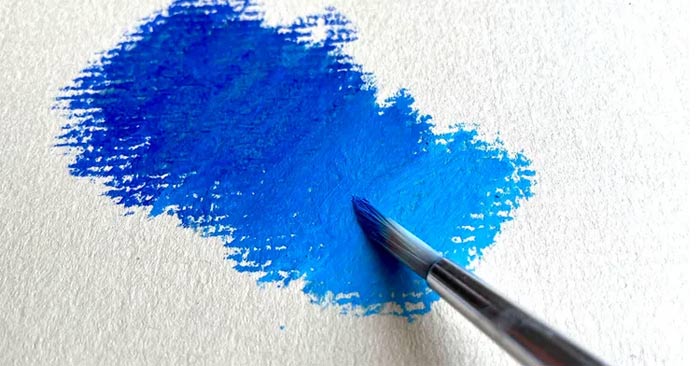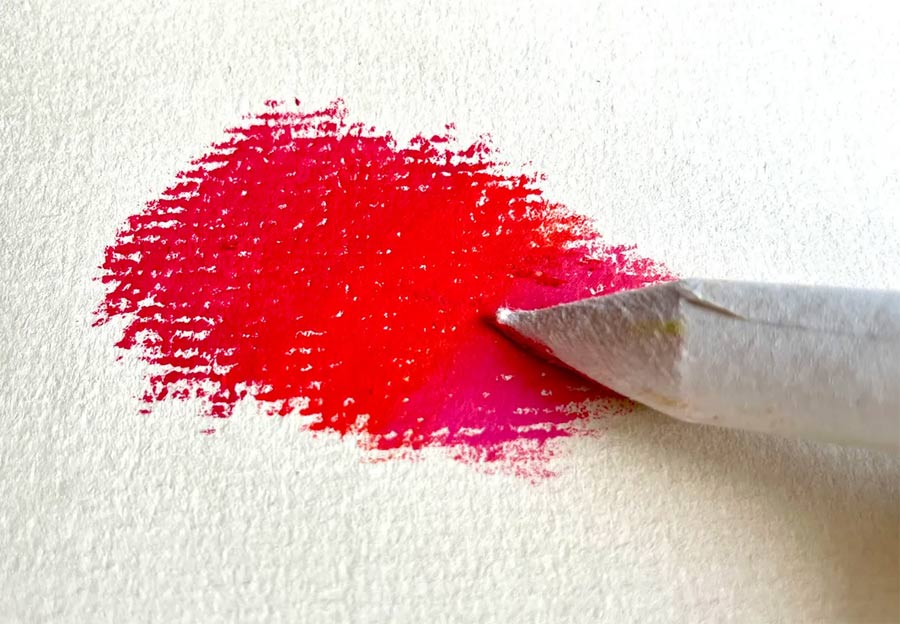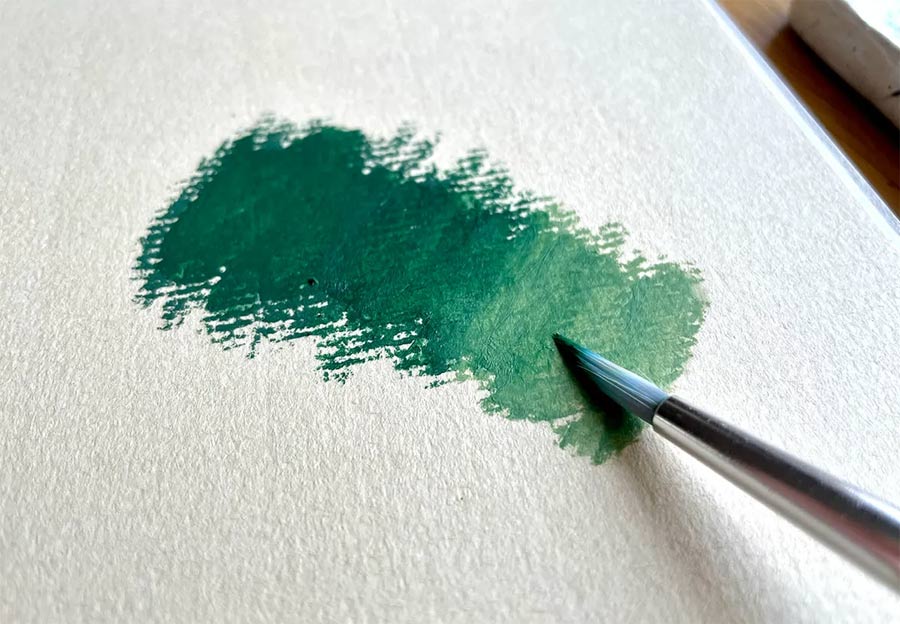How to mix beautiful oil pastels
Blending oil pastels like a pro will help you take your drawings to the next level! Let's explore the most beautiful and simple ways to blend oil pastels .

One of the great things about using oil pastels is that they blend incredibly easily – you can create smooth shades and blend the colors together on paper.
Oil pastels can even resemble oil paintings when applied thickly, with soft edges and rich colors.
There are many different ways to blend wax onto paper, so you can experiment with all of the options and find the method that works for you. They all have their pros and cons, so you should try a few methods until you find your favorite.
Many options are affordable and easy to find, so you don't need to spend extra money on extra materials if you're a beginner.
Blend with fingers
Finger blending is often the first method most artists try when working with oil pastels and it can yield great results!
The main downside is that your fingers can get dirty quickly, meaning you could accidentally smear other colors. You should wash your hands frequently if you use this technique, or keep some wet wipes nearby to clean your fingertips.
Mixed pile
If you want to keep your hands clean, blending sticks or tortillons can be helpful. These are paper sticks that you can use to smudge the pastels.
When the mixing paddle gets dirty, you can rub the tip with a kneaded eraser or remove some of the surface with sandpaper. Then your mixing paddle will look like new and you can get back to work!

Tissue
Paper towels are cheap and easy to find. You can crumple them up or shape them into a point to mix the wax together. Be careful not to rub your drawing too hard or the paper will disintegrate.
Foam insulation tube
This may sound like a strange suggestion, but don't be afraid to try it. Foam insulation tubing can be found at most hardware or DIY stores and can be cut into short pieces for easier handling. Rub it over your wax pastels to blend the colors together evenly.
Baby oil
If you are a parent, you probably already have a bottle of baby oil in your home. If not, baby oil is available at pharmacies and supermarkets and is very cheap.
Baby oil is actually mineral oil, so it's perfect for blending oil pastels together! Try not to use too much as it can make your paper greasy. Apply a little with a brush or cotton swab and blend to your liking.
Low odor solvent
Low odor solvents are commonly used with oil paints. Since pastels are also oil based, you can use solvents on them as well.
You can also use turpentine, but this has a very strong smell and is toxic, so you should use a less smelly alternative.
If using turpentine, make sure you are in a well-ventilated room. If any gets on your skin, wash it off with soap and water.
You can use a low odor solvent with a brush or cotton swab to smooth out your oil pastels. Add just a little at a time for best results.
When using for the first time, test on a piece of paper first so you know what the results will be like.

Use a palette knife
You can mix and blend colors directly onto the paper or separately in a palette. A palette knife can be used to blend the pastels in the palette before transferring to paper.
This approach gives you more control over the color mixing, but can be difficult to apply evenly on paper.
Clay eraser
Every artist should have one of these erasers in their kit. These soft erasers can be shaped with your hands, so you can mold them into a point if you like.
Just rub the eraser lightly over your drawing and see how easily the crayons blend!
Flaxseed oil
Turn your oil pastel drawing into an oil painting with a few drops of linseed oil. This dilutes the pigment and makes the resulting coloring effect more like paint! You can even move the oil pastel around with a brush.
Color layering
You can also blend the wax by coating it with another color. This can be used to create different effects at the same time.
For example, if a color is too bright, you can blend and tone it down at the same time by layering white, gray, or black over it.
Water
Some oil pastels are water soluble, so you can create a watercolor-like effect by brushing a little water over them. Be careful not to use too much or the paper will warp!
You should read it
- 10 secrets that every beautiful woman would never dare to admit
- 25 beautiful pictures of Vietnam make you say 'My country is so beautiful!'
- You will want to come to these 30 great locations before being invisible to the mirror
- Beautiful FB avatar, aggregated and beautiful FB avatar
- Top 9 beautiful tattoo websites
- Beautiful valentine card, beautiful valentine photo sent to your lover on February 14
- Beautiful background for Photoshop
- What is beautiful life and 29 ways to help you live beautiful
May be interested
- 5 types of hair that are both beautiful and suitable for going to play with Noel but she always ends up
 noel is about to come, have you chosen any beautiful hairstyle to hang out with? if not, please refer to 5 beautiful hairstyles below.
noel is about to come, have you chosen any beautiful hairstyle to hang out with? if not, please refer to 5 beautiful hairstyles below. - 21 beautiful photos you should see right away
 here are 21 beautiful photos in the world that you should watch.
here are 21 beautiful photos in the world that you should watch. - Beautiful Landscape Background, download Beautiful Landscape Background here
 beautiful landscape background. are you looking for beautiful landscape background templates to make photo collages or powerpoint backgrounds? with the landscape background samples in the article below, you will have diverse and rich choices.
beautiful landscape background. are you looking for beautiful landscape background templates to make photo collages or powerpoint backgrounds? with the landscape background samples in the article below, you will have diverse and rich choices. - The divine poses will give you a beautiful image of ecstasy
 do you know how to pose before the lens? or always be loyal to the v-style hand-raising. to help you have beautiful photos, the following article will show you 10 ways to pose when taking photos.
do you know how to pose before the lens? or always be loyal to the v-style hand-raising. to help you have beautiful photos, the following article will show you 10 ways to pose when taking photos. - The beautiful wooden doors
 wooden doors are often used to install the main door, acting as the facade of the house, so special attention is paid to the owner. doors made from natural wood are selected by many families because they bring a luxurious, warm home.
wooden doors are often used to install the main door, acting as the facade of the house, so special attention is paid to the owner. doors made from natural wood are selected by many families because they bring a luxurious, warm home. - 17 beautiful and modern tube house facade designs
 beautiful façade not only helps the house beautiful but also shows the personality and class of the homeowner.
beautiful façade not only helps the house beautiful but also shows the personality and class of the homeowner. - How to create beautiful covers in Word
 how to create beautiful covers in word nice cover will help your document more beautiful, more impressive at first sight. currently, there are many beautiful covers on the internet, but many of you want to design and create beautiful covers for yourself.
how to create beautiful covers in word nice cover will help your document more beautiful, more impressive at first sight. currently, there are many beautiful covers on the internet, but many of you want to design and create beautiful covers for yourself. - Beautiful Slide Wallpaper, download Beautiful Slide Wallpaper here
 beautiful slide wallpaper. this article shares beautiful slide wallpapers to help you find and choose the right slide background templates for your needs.
beautiful slide wallpaper. this article shares beautiful slide wallpapers to help you find and choose the right slide background templates for your needs. - Beautiful Blue Background, download Beautiful Blue Background here
 beautiful blue background. blue is the color that represents life, freedom and is the representative color of water and sky. this article shares the most beautiful green background templates for you.
beautiful blue background. blue is the color that represents life, freedom and is the representative color of water and sky. this article shares the most beautiful green background templates for you. - The most beautiful birthday cake
 the most beautiful birthday cake. you are looking for a beautiful birthday cake to give to your lover, friends, relatives? so you should refer to the most beautiful birthday cake that the article has summarized and shared below.
the most beautiful birthday cake. you are looking for a beautiful birthday cake to give to your lover, friends, relatives? so you should refer to the most beautiful birthday cake that the article has summarized and shared below.










 How to avoid drama and trouble
How to avoid drama and trouble How to fix Netflix 4K error
How to fix Netflix 4K error 5 ways to lower blood pressure with food
5 ways to lower blood pressure with food How to listen to music on laptop when closed without turning off
How to listen to music on laptop when closed without turning off How to create a digital signature in Word simply and quickly
How to create a digital signature in Word simply and quickly Clean your computer mouse properly, remove dust, increase lifespan
Clean your computer mouse properly, remove dust, increase lifespan